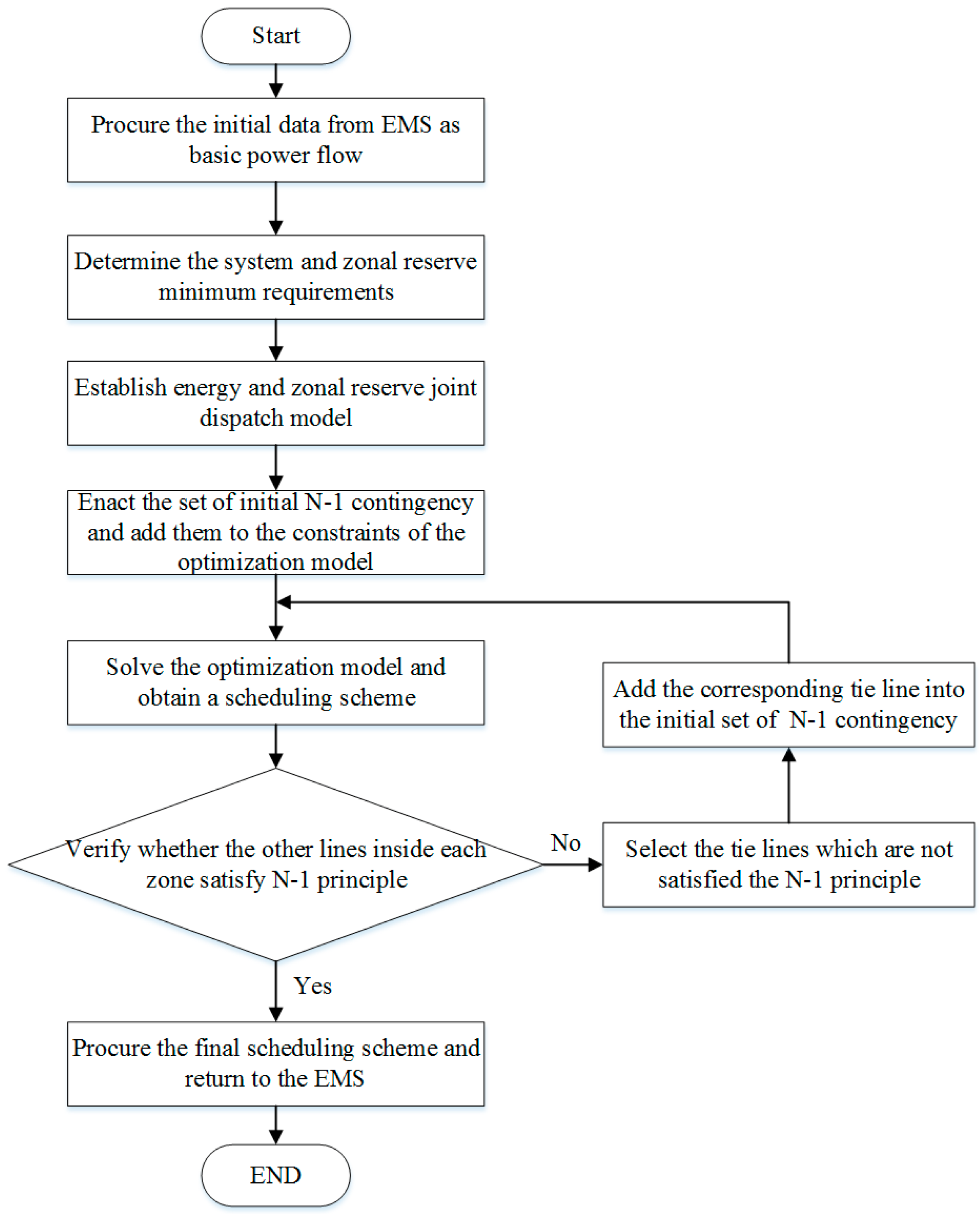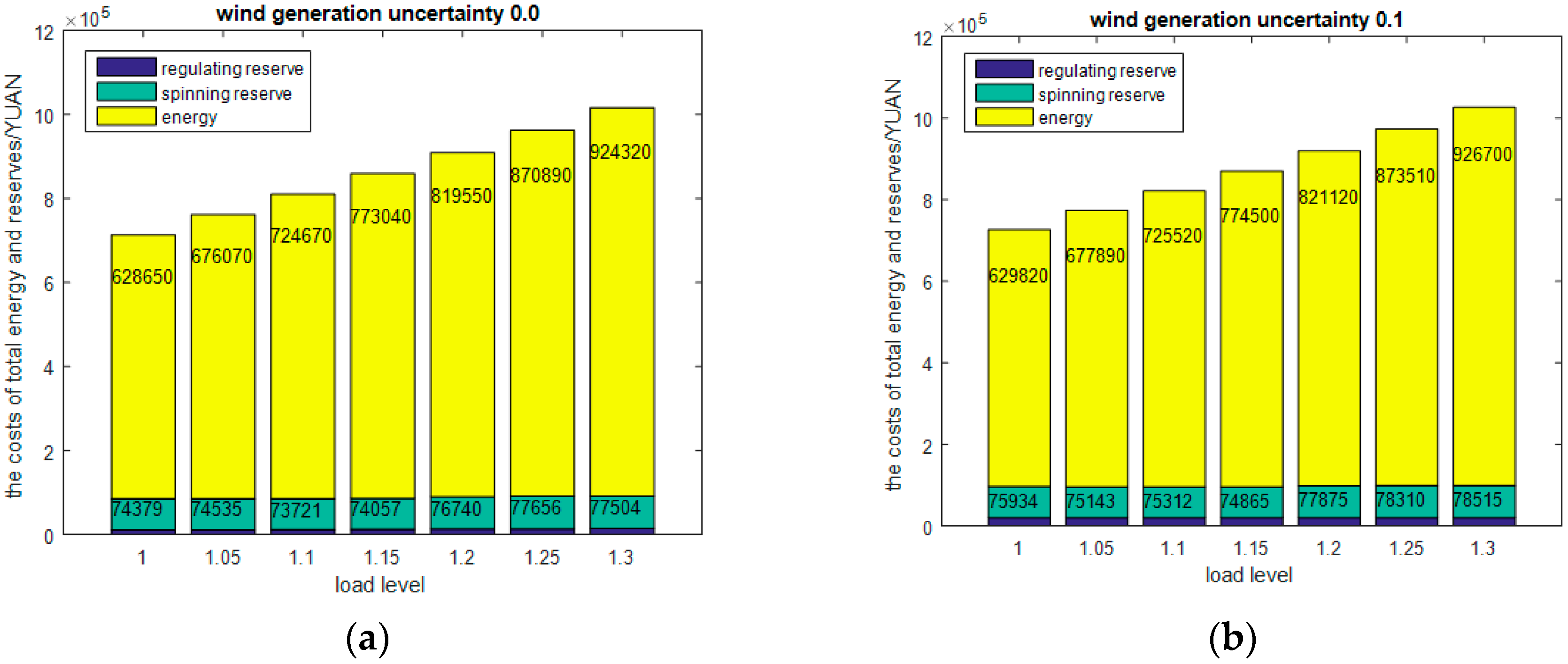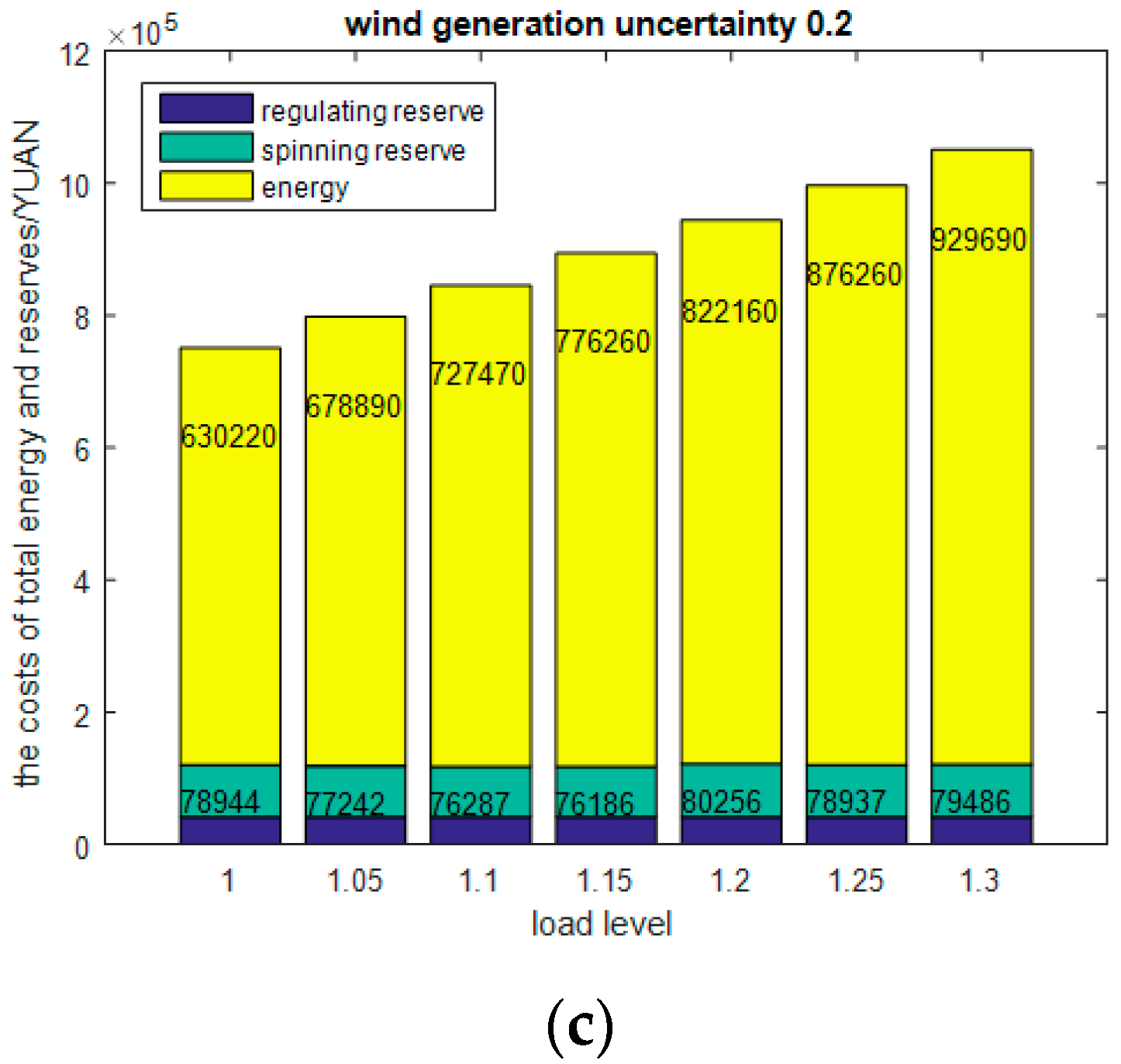Robust Co-Optimization to Energy and Reserve Joint Dispatch Considering Wind Power Generation and Zonal Reserve Constraints in Real-Time Electricity Markets
Abstract
:1. Introduction
- (1)
- An accurate probability distribution function of the uncertain parameters such as the wind power output, which is usually difficult to obtain and may lead to model insolubility [1], is not required;
- (2)
- Solutions are feasible even when the worst cases occur in practice [2];
- (3)
- With proper mathematical treatments of the robust model, the computational tractability can be realized [3].
- (1)
- The model proposed in this paper can generate a robust scheduling scheme immune to the largest fluctuation of the renewable energy output;
- (2)
- The zonal spinning reserves can enable the deliverability of spinning reserves, particularly when an outage of generators occurs;
- (3)
- The N-1 security criterion of unit and transmission lines is executed to guarantee the feasibility of the initial scheduling scheme. Moreover, the utilization of the active set method can improve the efficiency of solution.
2. Robust Co-Optimization to Energy and Reserve Joint Dispatch
3. Robust Co-Optimization Considering N-1 Constraints and Active Set Method
3.1. N-1 Contingency Constraints for Transmission Lines
3.2. N-1 Contingency Constraints for Generators
- (a)
- The participation factors are introduced to determine the regulating reserve cleared in the AGC units to balance the predicted errors of wind power generation outputs;
- (b)
- Through a great deal of power system stability and reliability offline simulation analysis, together with the forecasted wind generation outputs, the market wide requirement and each zonal requirement for regulating reserves and spinning reserves are determined;
- (c)
- Along with the basic constraints of the traditional economic dispatch model, the energy and zonal reserve joint dispatch model, considering wind power generation uncertainties to minimize the total energy and reserve costs, is established. In addition, the market wide requirement and each zonal requirement for reserves are taken into account in the constraints;
- (d)
- In the optimization model, contingencies on both generators and transmission lines are modeled explicitly. Since the N-1 contingencies on transmission lines and generators have different impacts on the re-distribution of the power flow, the modeling of the two elements is done separately.
- (e)
- To alleviate the computational burden, the contingency constraints are added into the model sequentially, and then all of contingencies will be examined whether all the N-1 feasibility criteria are satisfied. If one contingency check is failed, the N-1 constraints corresponding to this line outage will be added into the active set and further incorporated into the constraints of the above optimization model in Step 4. The new optimization model will be formulated and solved to obtain a new dispatch schedule. Repeat the above N-1 feasibility criteria check until all the N-1 contingency constraints are satisfied to formulate a feasible dispatch schedule in actual real-time electricity market.
4. Numerical Results
5. Conclusions
Acknowledgments
Author Contributions
Conflicts of Interest
Nomenclature
| Indexes and Sets | ||
| i | Index for the dispatchable unit i | |
| k | Index for the transmission line k | |
| a | Index for the AGC unit a | |
| r | Index for the dispatchable (but non-AGC) unit r | |
| j | Index for the load site j | |
| lk | Index for the transmission line k | |
| m | Index for the wind farm m | |
| Set of all generator sites | ||
| Set of all load sites | ||
| Set of all wind farms | ||
| Set of all AGC units | ||
| Set of all transmission lines | ||
| Variables | ||
| / | Scheduled generation of the dispatchable unit i/the AGC unit a | |
| Actual generation of the AGC unit a | ||
| / | Purchased capacities of up/down regulating reserve of the AGC unit a | |
| Spinning reserve of the dispatchable unit i | ||
| Power flow on the transmission line k | ||
| Scheduled energy dispatch for the generator i | ||
| Forecasting error of each wind farm m | ||
| Parameters | ||
| Bidding price of energy of the dispatchable unit i | ||
| Bidding prices of regulating reserve of the AGC unit a | ||
| Bidding prices of spinning reserve of the dispatchable unit i | ||
| Forecasted load demand of the site j | ||
| Total number of load sites | ||
| Total number of AGC units | ||
| Total number of dispatchable units | ||
| Total number of wind farms | ||
| Participation factor of the AGC unit a | ||
| / | Maximum/minimum output of the dispatchable unit i | |
| / | Maximum/minimum AGC limit of the AGC unit a | |
| / | Up/down regulating speed of the AGC unit a | |
| / | Response time of the regulating reserve/spinning reserve | |
| Minimum system spinning reserve requirements | ||
| Minimum zonal spinning reserve requirements | ||
| Number of dispatchable units in zone z. | ||
| Transmission capacity limit of the transmission line k | ||
| Lower bound of the variable | ||
| Upper bound of the variable | ||
| Forecasted wind power generation output of the wind farm m | ||
| H | Shift distribution factor matrix | |
| Shift distribution factor matrix under the outages of the s-th line outage | ||
| Shift distribution factor matrix under the outages of the u-th generator outage | ||
| Element located in (k, i) of the shift distribution factor matrix H | ||
| Element located in (k, i) of the shift distribution factor matrix | ||
| Element located in (k, i) of the shift distribution factor matrix | ||
Appendix A. The Derivation Procedure of Equations (A13)–(A17)
Appendix B. The Bidding Price of Generators in Real-Time Markets (¥/MW)
| Price | Energy | Regulating Reserve | Spinning Reserve | Price | Energy | Regulating Reserve | Spinning Reserve | ||
|---|---|---|---|---|---|---|---|---|---|
| Bus | Bus | ||||||||
| 1 | 150 | 0 | 87 | 65 | 236 | 0 | 142 | ||
| 4 | 320 | 0 | 83 | 66 | 273 | 0 | 153 | ||
| 6 | 210 | 120 | 92 | 69 | 281 | 0 | 120 | ||
| 8 | 176 | 0 | 95 | 70 | 293 | 140 | 126 | ||
| 10 | 286 | 0 | 97 | 72 | 302 | 154 | 93 | ||
| 12 | 217 | 153 | 103 | 73 | 288 | 136 | 106 | ||
| 15 | 274 | 129 | 153 | 74 | 219 | 0 | 108 | ||
| 18 | 138 | 0 | 82 | 76 | 342 | 0 | 104 | ||
| 19 | 229 | 0 | 98 | 77 | 274 | 0 | 100 | ||
| 24 | 270 | 0 | 102 | 80 | 163 | 0 | 90 | ||
| 25 | 250 | 0 | 93 | 85 | 192 | 0 | 120 | ||
| 26 | 240 | 0 | 107 | 87 | 172 | 0 | 110 | ||
| 27 | 170 | 0 | 96 | 89 | 164 | 0 | 120 | ||
| 31 | 192 | 0 | 89 | 90 | 196 | 0 | 101 | ||
| 32 | 163 | 0 | 79 | 91 | 162 | 0 | 126 | ||
| 34 | 275 | 176 | 142 | 92 | 183 | 0 | 139 | ||
| 36 | 239 | 157 | 139 | 99 | 247 | 0 | 143 | ||
| 40 | 291 | 139 | 128 | 100 | 274 | 0 | 150 | ||
| 42 | 327 | 0 | 142 | 103 | 250 | 0 | 97 | ||
| 46 | 140 | 0 | 129 | 104 | 261 | 0 | 85 | ||
| 49 | 218 | 0 | 148 | 105 | 207 | 0 | 70 | ||
| 54 | 265 | 0 | 128 | 107 | 183 | 0 | 130 | ||
| 55 | 294 | 0 | 118 | 110 | 196 | 0 | 86 | ||
| 56 | 143 | 0 | 116 | 111 | 278 | 0 | 94 | ||
| 59 | 302 | 0 | 102 | 112 | 321 | 0 | 92 | ||
| 61 | 276 | 0 | 137 | 113 | 298 | 0 | 97 | ||
| 62 | 247 | 0 | 142 | 116 | 169 | 0 | 83 | ||
References
- Ben-Tal, A.; Nemirovski, A. Robust optimization—Methodology and applications. Math. Prog. 2002, 92, 453–480. [Google Scholar] [CrossRef]
- Beyer, H.G.; Sendhoff, B. Robust optimization—A comprehensive survey. Comput. Methods Appl. Mech. Eng. 2007, 196, 3190–3218. [Google Scholar] [CrossRef]
- Ben-Tal, A.; El Ghaoui, L.; Nemirovski, A. Robust Optimization; Princeton University Press: Princeton, NJ, USA, 2009. [Google Scholar]
- Kumar, L.V.S.; Kumar, G.V.N.; Madichetty, S. Pattern search algorithm based automatic online parameter estimation for AGC with effects of wind power. Int. J. Electr. Power Energy Syst. 2017, 84, 135–142. [Google Scholar] [CrossRef]
- Ding, T.; Wu, Z.Y.; Lv, J.; Bie, Z.; Zhang, X. Robust co-optimization to energy and ancillary service joint dispatch considering wind power uncertainties in real-time electricity markets. IEEE Trans. Sustain. Energy 2016, 7, 1547–1557. [Google Scholar] [CrossRef]
- Bertsekas, D.P. Robust shortest path planning and semicontractive dynamic programming. NRL 2016, 1–23. [Google Scholar] [CrossRef]
- Bertsimas, D.; Litvinov, E.; Sun, X.A.; Zhao, J.; Zheng, T. Adaptive tobust optimization for the security constrained unit commitment problem. IEEE Trans. Power Syst. 2013, 28, 52–63. [Google Scholar] [CrossRef]
- Yu, H.; Rosehart, W.D. An optimal power flow algorithm to achieve robust operation considering load and renewable generation uncertainties. IEEE Trans. Power Syst. 2012, 27, 1808–1817. [Google Scholar] [CrossRef]
- Vilim, M.; Botterud, A. Wind power bidding in electricity markets with high wind penetration. Appl. Energy 2014, 118, 141–155. [Google Scholar] [CrossRef]
- Knispel, T.; Laeven, R.J.A.; Svindland, G. Robust optimal risk sharing and risk premia in expanding pools. Math. Econ. 2016, 70, 182–195. [Google Scholar] [CrossRef]
- Wu, W.; Chen, J.; Zhang, B.; Sun, H. A robust wind power optimization method for look-ahead power dispatch. IEEE Trans. Sustain. Energy 2014, 5, 507–515. [Google Scholar] [CrossRef]
- Pan, I.; Das, S. Fractional order AGC for distributed energy resources using robust optimization. IEEE Trans. Smart Grid 2016, 7, 2175–2186. [Google Scholar] [CrossRef]
- Thatte, A.A.; Xie, L.; Viassolo, D.E.; Singh, S. Risk measure based robust bidding strategy for arbitrage using a wind farm and energy storage. IEEE Trans. Smart Grid 2013, 4, 2191–2199. [Google Scholar] [CrossRef]
- Woo, C.K.; Moore, J.; Schneiderman, B.; Ho, T.; Olson, A.; Alagappan, L. Merit-order effects of renewable energy and price divergence in California’s day-ahead and real-time electricity markets. Energy Policy 2016, 92, 299–312. [Google Scholar] [CrossRef]
- Lee, F.N.; Chen, Q.; Breipohl, A.M. Unit commitment risk with sequential rescheduling. IEEE Trans. Power Syst. 1991, 6, 1017–1023. [Google Scholar] [CrossRef]
- Zugno, M.; Conejo, A.J. A robust optimization approach to energy and reserve dispatch in electricity markets. Eur. J. Oper. Res. 2015, 247, 659–671. [Google Scholar] [CrossRef]
- Chen, Y.; Keyser, M.; Tackett, M.H.; Leonard, R.; Gardner, J. Incorporating short-term stored energy resource into MISO energy and ancillary service market and development of performance-based regulation payment. Energy Storage Smart Grids 2015, 171–199. [Google Scholar] [CrossRef]
- Ma, X.; Sun, D. Energy and ancillary service dispatch in a competitive pool. IEEE Power Eng. Rev. 1998, 18, 54–56. [Google Scholar]
- Chen, Y.; Gribik, P.; Gardner, J. Incorporating post zonal reserve deployment transmission constraints into energy and ancillary service co-optimization. IEEE Trans. Power Syst. 2014, 29, 537–549. [Google Scholar] [CrossRef]
- Chen, Y.; Gribik, P.R.; Zhang, L.; Merring, R.; Gardner, J.; Sperry, K. Real time ramp model in Midwest iso co-optimized energy and ancillary service market design. In Proceedings of the 2009 IEEE Power & Energy Society General Meeting, Calgary, AB, Canada, 26–30 July 2009; pp. 1–8. [Google Scholar]
- Ma, X.; Chen, Y.; Wan, J. Midwest ISO co-optimization based real-time dispatch and pricing of energy and ancillary services. In Proceedings of the 2009 IEEE Power & Energy Society General Meeting, Calgary, AB, Canada, 26–30 July 2009; pp. 1–6. [Google Scholar]
- Ma, X.; Song, H.; Hong, M.; Wan, J. The security-constrained commitment and dispatch for Midwest ISO day-ahead co-optimized energy and ancillary service market. In Proceedings of the 2009 IEEE Power & Energy Society General Meeting, Calgary, AB, Canada, 26–30 July 2009; pp. 1–8. [Google Scholar]
- Zheng, T.; Litvinov, E. Contingency-based zonal reserve modeling and pricing in a co-optimized energy and reserve market. IEEE Trans. Power Syst. 2008, 23, 277–286. [Google Scholar] [CrossRef]
- Motalleb, M.; Thornton, M.; Reihani, E.; Ghorbani, R. A nascent market for contingency reserve services using demand response. Appl. Energy 2016, 179, 985–995. [Google Scholar] [CrossRef]
- Aghaei, J.; Alizadeh, M.I. Robust N-k contingency constrained unit commitment with ancillary service demand response program. IET Gener. Transm. Distrib. 2014, 8, 1928–1936. [Google Scholar] [CrossRef]
- Ding, T.; Zhao, C. Robust optimal transmission switching with the consideration of corrective actions for N-k contingencies. IET Gener. Transm. Distrib. 2016, 10, 3288–3295. [Google Scholar] [CrossRef]
- Jabr, R.A. Adjustable robust OPF with renewable energy sources. IEEE Trans. Power Syst. 2013, 28, 4742–4751. [Google Scholar] [CrossRef]
- MATPOWER. Available online: http://www.pserc.cornell.edu/matpower (accessed on 15 November 2016).
- Ye, H.; Ge, Y.; Shahidehpour, M.; Li, Z. Uncertainty marginal price, transmission reserve, and day-ahead market clearing with robust unit commitment. IEEE Trans. Power Syst. 2016. [Google Scholar] [CrossRef]




| Minimum Requirements of Regulating and Spinning Reserve | Minimum Requirements of Zonal Regulating and Spinning Reserve | ||||
|---|---|---|---|---|---|
| Zone I | Zone II | Zone III | |||
| 42.42 | 339.36 | 805.2 | 96.3 | 134.2 | 193.7 |
| Uncertainty Degree | Load Level | 1.00 | 1.05 | 1.10 | 1.15 | 1.20 | 1.25 |
|---|---|---|---|---|---|---|---|
| 0% | Costs (YUAN) | 10,491 | 11,053 | 11,631 | 12,310 | 13,156 | 13,733 |
| 10% | Costs (YUAN) | 20,810 | 21,822 | 22,834 | 23,846 | 24,858 | 25,870 |
| 20% | Costs (YUAN) | 41,620 | 43,761 | 45,902 | 48,043 | 50,184 | 52,325 |
| Wind Power Uncertainty | 0 | 0.05 | 0.10 | 0.15 | 0.20 | 0.25 | 0.30 | |
|---|---|---|---|---|---|---|---|---|
| Spinning Reserve | ||||||||
| With consideration of zonal reserve (MW) | I | 358.58 | 360.35 | 349.70 | 339.06 | 328.41 | 317.76 | 307.11 |
| II | 134.20 | 134.20 | 134.20 | 134.20 | 134.20 | 134.20 | 134.20 | |
| III | 312.42 | 310.65 | 321.30 | 331.94 | 324.59 | 353.24 | 363.89 | |
| Without consideration of zonal reserve (MW) | I | 420.00 | 420.00 | 420.00 | 420.00 | 420.00 | 415.03 | 397.00 |
| II | 0.00 | 7.39 | 14.77 | 22.16 | 29.54 | 36.93 | 44.32 | |
| III | 385.20 | 377.81 | 370.43 | 363.00 | 355.65 | 353.24 | 363.89 |
| Methods | N-L | C-L | I-L | A-L |
|---|---|---|---|---|
| Time (s) | 0.1716 | 0.8418 | 3.2926 | 43.3617 |
| Violated Transmission Lines | #44, #51, #54, #76, #79, #84, #88, #90,#105, #106 | #76, #79, #84, #88, #90 | - | - |
© 2017 by the authors. Licensee MDPI, Basel, Switzerland. This article is an open access article distributed under the terms and conditions of the Creative Commons Attribution (CC BY) license (http://creativecommons.org/licenses/by/4.0/).
Share and Cite
Li, C.; Yun, J.; Ding, T.; Liu, F.; Ju, Y.; Yuan, S. Robust Co-Optimization to Energy and Reserve Joint Dispatch Considering Wind Power Generation and Zonal Reserve Constraints in Real-Time Electricity Markets. Appl. Sci. 2017, 7, 680. https://doi.org/10.3390/app7070680
Li C, Yun J, Ding T, Liu F, Ju Y, Yuan S. Robust Co-Optimization to Energy and Reserve Joint Dispatch Considering Wind Power Generation and Zonal Reserve Constraints in Real-Time Electricity Markets. Applied Sciences. 2017; 7(7):680. https://doi.org/10.3390/app7070680
Chicago/Turabian StyleLi, Chunlai, Jingyang Yun, Tao Ding, Fan Liu, Yuntao Ju, and Shun Yuan. 2017. "Robust Co-Optimization to Energy and Reserve Joint Dispatch Considering Wind Power Generation and Zonal Reserve Constraints in Real-Time Electricity Markets" Applied Sciences 7, no. 7: 680. https://doi.org/10.3390/app7070680
APA StyleLi, C., Yun, J., Ding, T., Liu, F., Ju, Y., & Yuan, S. (2017). Robust Co-Optimization to Energy and Reserve Joint Dispatch Considering Wind Power Generation and Zonal Reserve Constraints in Real-Time Electricity Markets. Applied Sciences, 7(7), 680. https://doi.org/10.3390/app7070680






